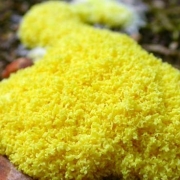Phoma
A common soil fungi that contains many plant pathogenic species.The most important species include phoma beta which is the cause of the heart rot and blight of beets, and phoma batata that produces a dry rot of sweet potatoes.
Multicellular chlamydospores produced along the vegetative hyphae, often resembling conidia of Alternaria or Ulocladium. It is a contaminant / opportunistic pathogen, found on plant material and soil. Reported to be a common allergen found indoors on painted walls (including the shower) and on a variety of other surfaces including cement, rubber, and butter. Some believe its effect on indoor air is not that significant because its spores do not travel well via air currents. Some species are linked to occasional eye, skin, and subcutaneous infections.
Further Reading
- Abdel-Gawad, K.M., & Zohri, A.A., Fungal flora and mycotoxins of six kinds of nut seeds for human consumption in Saudi Arabia, Mycopathologia 124 (1993) 55-64.
- Aisner, J., Schimpff, S.C., Bennett, J.E., Young, V.M., Wiernik, P.H., Aspergillus infections in cancer patiens. Association with fireproofing materials in a new hospital. J.Am. Med. Assoc. 235 (1976) 411-412.
- Ajello, L., Hyalohyphomycosis and phaeohyphomycosis: two global disease entities of public health importance. Eur. J. Epidemiol. 1(1986) 243-251.
- Al-Suwaine, A.S., Bahkali, A.H., Hasnain, S.M., Seasonal incidence of airborne fungal allergens in Riyadh, Saudi Arabia. Mycopathologia 145(1999)15-22.







